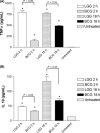Lactobacillus rhamnosus GG induces tumor regression in mice bearing orthotopic bladder tumors
- PMID: 20015287
- PMCID: PMC11159805
- DOI: 10.1111/j.1349-7006.2009.01426.x
Lactobacillus rhamnosus GG induces tumor regression in mice bearing orthotopic bladder tumors
Abstract
The present gold standard for bladder cancer is Mycobacterium bovis, Bacillus Calmette Guerin (BCG) immunotherapy. But it has a non-responder rate of 30-50% and side effects are common. Lactobacillus casei strain Shirota has been reported to reduce the incidence of recurrence in bladder cancer patients and to cure tumor-bearing mice. Our aim was to determine if Lactobacillus rhamnosus GG (LGG) could be as efficacious as BCG in a murine model of bladder cancer. MB49 bladder cancer cells secreting human prostate-specific antigen were implanted orthotopically in female C57BL/6 mice and urinary prostate-specific antigen levels were used as a marker of tumor growth. Mice were treated with either live or lyophilized LGG given via intravesical instillation, or both oral and intravesical LGG given once a week for a period of 6 weeks starting at day 4 after tumor implantation. A comparison of LGG and BCG immunotherapy was also carried out. LGG therapy (live or lyophilized) significantly (P = 0.006) increased the number of cured mice. Cytokine arrays and immune cell recruitment analysis revealed differences between untreated, treated, cured, and tumor-bearing mice. LGG therapy restored XCL1 levels to those in healthy bladders. LGG also recruited large numbers of neutrophils and macrophages to the tumor site. Intravesical LGG and BCG immunotherapy had cure rates of 89 and 77%, respectively, compared with 20% in untreated mice. LGG has the potential to replace BCG immunotherapy for the treatment of bladder cancer.
Figures



Similar articles
-
Expression of chemokine/cytokine genes and immune cell recruitment following the instillation of Mycobacterium bovis, bacillus Calmette-Guérin or Lactobacillus rhamnosus strain GG in the healthy murine bladder.Immunology. 2008 Jul;124(3):419-27. doi: 10.1111/j.1365-2567.2007.02792.x. Epub 2008 Jan 22. Immunology. 2008. PMID: 18217952 Free PMC article.
-
Chemopreventive effect of Lactobacillus rhamnosus on growth of a subcutaneously implanted bladder cancer cell line in the mouse.Jpn J Cancer Res. 2002 Jan;93(1):36-41. doi: 10.1111/j.1349-7006.2002.tb01198.x. Jpn J Cancer Res. 2002. PMID: 11802806 Free PMC article.
-
Antitumor effects of the intravesical instillation of heat killed cells of the Lactobacillus casei strain Shirota on the murine orthotopic bladder tumor MBT-2.J Urol. 2001 Dec;166(6):2506-11. J Urol. 2001. PMID: 11696819
-
Bacillus Calmette-Guérin immunotherapy for bladder cancer: a review of immunological aspects, clinical effects and BCG infections.APMIS. 2020 Feb;128(2):92-103. doi: 10.1111/apm.13011. Epub 2020 Jan 28. APMIS. 2020. PMID: 31755155 Review.
-
Diagnosis and management of superficial bladder cancer.Curr Probl Cancer. 2001 Jul-Aug;25(4):219-78. doi: 10.1067/mcn.2001.117539. Curr Probl Cancer. 2001. PMID: 11514784 Review.
Cited by
-
Bactofection, Bacterial-Mediated Vaccination, and Cancer Therapy: Current Applications and Future Perspectives.Vaccines (Basel). 2024 Aug 27;12(9):968. doi: 10.3390/vaccines12090968. Vaccines (Basel). 2024. PMID: 39340000 Free PMC article. Review.
-
Bacterial nanotechnology as a paradigm in targeted cancer therapeutic delivery and immunotherapy.Microsyst Nanoeng. 2024 Aug 20;10:113. doi: 10.1038/s41378-024-00743-z. eCollection 2024. Microsyst Nanoeng. 2024. PMID: 39166136 Free PMC article. Review.
-
A Combination of Curcumin and Lactobacillus rhamnosus GG Inhibits Viability and Induces Apoptosis in SCC-9 Human Oral Squamous Cell Carcinoma Cells.J Evid Based Integr Med. 2024 Jan-Dec;29:2515690X241258369. doi: 10.1177/2515690X241258369. J Evid Based Integr Med. 2024. PMID: 38778767 Free PMC article.
-
Exploring the regulatory mechanism of intestinal flora based on PD-1 receptor/ligand targeted cancer immunotherapy.Front Immunol. 2024 Mar 28;15:1359029. doi: 10.3389/fimmu.2024.1359029. eCollection 2024. Front Immunol. 2024. PMID: 38617841 Free PMC article. Review.
-
Uncovering Microbial Composition of the Tissue Microenvironment in Bladder Cancer using RNA Sequencing Data.J Cancer. 2024 Mar 4;15(8):2431-2441. doi: 10.7150/jca.93055. eCollection 2024. J Cancer. 2024. PMID: 38495492 Free PMC article.
References
-
- Nseyo UO, Lamm DL. Immunotherapy of bladder cancer. Semin Surg Oncol 1997; 13: 342–9. - PubMed
-
- Alexandroff AB, Jackson AM, O’Donnell MA, James K. BCG immunotherapy of bladder cancer: 20 years on. Lancet 1999; 353: 1689–94. - PubMed
-
- Amling CL. Diagnosis and management of superficial bladder cancer. Curr Probl Cancer 2001; 25: 219–78. - PubMed
-
- Brandau S, Suttmann H. Thirty years of BCG immunotherapy for non‐muscle invasive bladder cancer: a success story with room for improvement. Biomed Pharmacother 2007; 61: 299–305. - PubMed
-
- Aso Y, Akaza H, Kotake T, Tsukamoto T, Imai K, Naito S. Preventive effect of a Lactobacillus casei preparation on the recurrence of superficial bladder cancer in a double‐blind trial. Eur Urol 1995; 27: 104–9. - PubMed
Publication types
MeSH terms
Substances
LinkOut - more resources
Full Text Sources
Other Literature Sources
Medical

